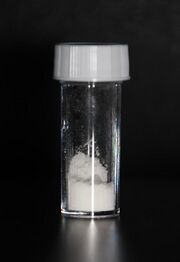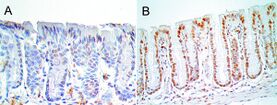Chemistry:Deoxycholic acid

| |

| |

| |
| Names | |
|---|---|
| IUPAC name
3α,12α-Dihydroxy-5β-cholan-24-oic acid
| |
| Systematic IUPAC name
(4R)-4-[(1R,3aS,3bR,5aR,7R,9aS,9bS,11S,11aR)-7,11-Dihydroxy-9a,11a-dimethylhexadecahydro-1H-cyclopenta[a]phenanthren-1-yl]pentanoic acid | |
| Other names
Deoxycholate
| |
| Identifiers | |
3D model (JSmol)
|
|
| 3DMet | |
| ChEBI | |
| ChEMBL | |
| ChemSpider | |
| DrugBank | |
| KEGG | |
PubChem CID
|
|
| UNII | |
| |
| |
| Properties | |
| C24H40O4 | |
| Molar mass | 392.580 g·mol−1 |
| Melting point | 174–176 °C (345–349 °F; 447–449 K) |
| 0.024%[1] | |
| Acidity (pKa) | 6.58[2] |
| -272.0·10−6 cm3/mol | |
| Pharmacology | |
| 1=ATC code }} | D11AX24 (WHO) |
| |
| Legal status | |
Except where otherwise noted, data are given for materials in their standard state (at 25 °C [77 °F], 100 kPa). | |
| Infobox references | |
| Clinical data | |
|---|---|
| Trade names | Kybella, Belkyra |
| AHFS/Drugs.com | Monograph |
| License data | |
| Identifiers | |
| PDB ligand | |
Deoxycholic acid is a bile acid. Deoxycholic acid is one of the secondary bile acids, which are metabolic byproducts of intestinal bacteria. The two primary bile acids secreted by the liver are cholic acid and chenodeoxycholic acid. Bacteria metabolize chenodeoxycholic acid into the secondary bile acid lithocholic acid, and they metabolize cholic acid into deoxycholic acid. There are additional secondary bile acids, such as ursodeoxycholic acid. Deoxycholic acid is soluble in alcohol and acetic acid. When pure, it exists in a white to off-white crystalline powder form.
Deoxycholic acid is available as a generic medication in the United States as of April 2021, sold under the brand name Kybella among others.[8]
Applications
Deoxycholic acid has been used since its discovery in various fields of human medicine. In the human body deoxycholic acid is used in the emulsification of fats for absorption in the intestine. It has, in some countries (including Switzerland) been licensed as an emulsifier in food industry,[9] but it is no longer common. Outside the body it is used in experimental basis of cholagogues and is also in use to prevent and dissolve gallstones.[citation needed]
In research deoxycholic acid is used as a mild detergent for the isolation of membrane associated proteins. The critical micelle concentration for deoxycholic acid is approximately 2.4–4 mM.[10]
Sodium deoxycholate, the sodium salt of deoxycholic acid, is often used as a biological detergent to lyse cells and solubilise cellular and membrane components.[11] Sodium deoxycholate mixed with phosphatidylcholine, is used in mesotherapy injections to produce lipolysis, and has been used as an alternative to surgical excision in the treatment of lipomas.[12]
Deoxycholates and bile acid derivatives in general are actively being studied as structures for incorporation in nanotechnology.[13] They also have found application in microlithography as photoresistant components.[14]
In the United States, deoxycholic acid, under the brand name Kybella, is approved by the Food and Drug Administration for reducing moderate-to-severe fat below the chin.[6][15] When injected into submental fat, deoxycholic acid helps destroy (adipocytes) fat cells, which are metabolized by the body over the course of several months.[15] Kybella is produced by Kythera Biopharmaceuticals.[16][17]
Research in immunology
Its function as a detergent and isolating agent for membrane proteins also suits it for production of outer membrane protein (OMP) vaccines such as MenB, a Norwegian vaccine developed in the early 1990s.[18] The MeNZB vaccine was produced using the same method.[19]
Deoxycholic acid binds and activates the membrane enzyme NAPE-PLD, which catalyzes the release of the endogenous cannabinoid anandamide and other N-acylethanolamines. These bioactive signaling molecules play important roles in several physiological pathways including stress and pain response, appetite, and lifespan.[20]
Some publications point towards the effect of deoxycholic acid as an immunostimulant[21][22] of the innate immune system, activating its main actors, the macrophages. According to these publications, a sufficient amount of deoxycholic acid in the human body would correspond with a good immune reaction of the non-specific immune system. Clinical studies conducted in the 1970s and 1980s confirm the expectation that deoxycholic acid is involved in the natural healing processes of local inflammations,[23][24] different types of herpes,[25][26] and possibly cancer.[27][28]
Research in cancer
Deoxycholate and other secondary bile acids cause DNA damage.[29] Secondary bile acids increase intracellular production of reactive oxygen and reactive nitrogen species resulting in increased oxidative stress and DNA damage.[30][31] As shown in the figure below, deoxycholate added to the diet of mice increased the level of 8-oxo-dG, an oxidative DNA damage, in the colonic epithelium of mice. When the level of deoxycholate-induced DNA damage is high, DNA repair enzymes that ordinarily reverse DNA damage may not be able to keep up.[citation needed]
DNA damage has frequently been proposed as a major cause of cancer.[32][33] DNA damage can give rise to cancer by causing mutations.[citation needed]
When deoxycholate was added to the food of mice so that their feces contained deoxycholate at about the same level present in feces of human on a high fat diet, 45% to 56% of the mice developed colon cancer over the next 10 months, while none of the mice on a diet without deoxycholate developed cancer.[34][35] Thus, exposure of the colon to deoxycholate may cause cancer in mice. However, this same study reported that, when chlorogenic acid was added to the diet alongside deoxycholate, only 18% of the mice developed colon cancer. Chlorogenic acid is a component of common foods and beverages; coffee contains an average of 53.8 mg chlorogenic acid per 100 ml.[36] Therefore, to consume the level of chlorogenic acid used in the study, a human on a "standard" 2000-calorie daily diet (416 g/d; 250g carbs, 100g protein, 66g fat) would need to consume roughly 55 mL of coffee each day, or just under 2 fluid ounces.
In humans, higher levels of colonic deoxycholate are associated with higher frequencies of colon cancer. As an example, the fecal deoxycholate concentrations in African Americans (who eat a relatively high fat diet) is more than five times higher than fecal deoxycholate of Native Africans in South Africa (who eat a low fat diet).[37] Male African Americans have a high incidence of colon cancer of 72 per 100,000,[38] while Native Africans in South Africa have a low incidence rate of colon cancer of less than 1 per 100,000,[39] a more than 72-fold difference in rates of colon cancer.
A prospective human study investigating the relationship between microbial metabolites and cancer found a strong correlation between circulating deoxycholic acid and colorectal cancer risk in women.[40]
Factors affecting deoxycholate levels
A number of factors, including diet, obesity, and exercise, affect the level of deoxycholate in the human colon. When humans were switched from their usual diet to a meat, egg and cheese based diet for five days, deoxycholate in their feces increased by factors of 2 to 10 fold.[41] Rats fed diets with 30% beef tallow (high fat) had almost 2-fold more deoxycholate in their feces than rats fed 5% beef tallow (low fat).[42] In the same study, adding the further dietary elements of curcumin or caffeic acid to the rats' high fat (30% beef tallow) diet reduced the deoxycholate in their feces to levels comparable to levels seen in the rats on a low fat diet. Curcumin is a component of the spice turmeric, and caffeic acid is a component high in some fruits and spices.[43] Caffeic acid is also a digestive break-down product of chlorogenic acid, high in coffee and some fruits and vegetables.[44]

In addition to fats, the type or amount of protein in the diet may also affect bile acid levels. Switching from a diet with protein provided by casein to a diet with protein provided by salmon protein hydrolysate led to as much as a 6-fold increase in levels of bile acids in the blood plasma of rats.[45] In humans, adding high protein to a high fat diet raised the level of deoxycholate in the plasma by almost 50%.[46]
Obesity has been linked to cancer,[47] and this link is in part through deoxycholate.[48][49][50] In obese people, the relative proportion of Firmicutes (Gram-positive bacteria) in gut microbiota is increased resulting in greater conversion of the non-genotoxic primary bile acid, cholic acid, to carcinogenic deoxycholate.[48]
Exercise decreases deoxycholate in the colon. Humans whose level of physical activity placed them in the top third had a 17% decrease in fecal bile acid concentration compared to those whose level of physical activity placed them in the lowest third.[51] Rats provided with an exercise wheel had a lower ratio of secondary bile acids to primary bile acids than sedentary rats in their feces.[52] There is a positive association of exercise and physical activity with cancer prevention, tolerance to cancer-directed therapies (radiation and chemotherapy), reduction in recurrence, and improvement in survival.[53]
References
- ↑ "Deoxycholic acid". Sigma Aldrich. http://www.sigmaaldrich.com/etc/medialib/docs/Sigma/Product_Information_Sheet/d2510pis.Par.0001.File.tmp/d2510pis.pdf.
- ↑ Handbook of Chemistry and Physics (87 ed.). Boca Raton, FL: CRC Press. 1998. p. 1287. ISBN 978-0-8493-0594-8.
- ↑ 3.0 3.1 "Belkyra (deoxycholic acid solution for injection) Product Information" (PDF). https://www.ebs.tga.gov.au/ebs/picmi/picmirepository.nsf/pdf?OpenAgent&id=CP-2016-PI-02296-1.
- ↑ https://www.ebs.tga.gov.au/servlet/xmlmillr6?dbid=ebs/PublicHTML/pdfStore.nsf&docid=6CC2E7A2D27AA7C5CA2585D80042A1CC&agid=(PrintDetailsPublic)&actionid=1[yes|permanent dead link|dead link}}]
- ↑ "Prescription medicines: registration of new chemical entities in Australia, 2016". 21 June 2022. https://www.tga.gov.au/prescription-medicines-registration-new-chemical-entities-australia-2016.
- ↑ 6.0 6.1 "Kybella- deoxycholic acid injection, solution". https://dailymed.nlm.nih.gov/dailymed/drugInfo.cfm?setid=fe431ed4-ea6f-4e99-b4bc-ec25ae7b8553.
- ↑ "Active substance: deoxycholic acid". European Medicines Agency (EMA). 10 December 2020. https://www.ema.europa.eu/documents/psusa/deoxycholic-acid-list-nationally-authorised-medicinal-products-psusa/00010525/202004_en.pdf.
- ↑ "Deoxycholic acid: FDA-Approved Drugs". https://www.accessdata.fda.gov/scripts/cder/daf/index.cfm?event=overview.process&ApplNo=212296.
- ↑ "Chapter 58". SLMB – Schweizer Lebensmittelbuch 4 (3). 1992.
- ↑ "Detergents: An overview". Guide to Protein Purification. Methods in Enzymology. 182. Academic Press. 1990. pp. 239–53. doi:10.1016/0076-6879(90)82020-3. ISBN 9780121820831.
- ↑ "Sodium deoxycholate". nzp.co.nz. http://www.nzp.co.nz/products.php?cid=2&pid=251.
- ↑ "Injectable therapies for localized fat loss: state of the art". Clinics in Plastic Surgery 38 (3): 489–501, vii. July 2011. doi:10.1016/j.cps.2011.02.005. PMID 21824545.
- ↑ "A Simple Method for Synthesis of Active Esters of Isonicotinic and Picolinic Acids". Molecules 6 (12): 47–51. 2001. doi:10.3390/60100047.
- ↑ "193-nm Photoresists Based on Norbornene Copolymers with Derivatives of Bile Acid". Chemistry Letters 29 (4): 414–15. 2000. doi:10.1246/cl.2000.414.
- ↑ 15.0 15.1 "FDA approves treatment for fat below the chin". Food and Drug Administration. April 29, 2015. https://www.fda.gov/NewsEvents/Newsroom/PressAnnouncements/ucm444978.htm.
- ↑ "ATX-101 – Kythera Biopharmaceuticals". Kythera.com. 2014-06-20. http://www.kythera.com/products/atx-101/.
- ↑ "Double chin begone: It's an FDA yes for fat buster". CNN. 2015-05-01. http://www.cnn.com/2015/04/30/health/chin-fat-drug-fda-approval/.
- ↑ "Production, characterization and control of MenB-vaccine "Folkehelsa": an outer membrane vesicle vaccine against group B meningococcal disease". NIPH Annals 14 (2): 67–79; discussion 79–80. December 1991. PMID 1812438.
- ↑ "MeNZB – Use science not opinion!". scoop.co.nz. 10 June 2005. http://www.scoop.co.nz/stories/GE0506/S00048.htm.
- ↑ "Structure of human N-acylphosphatidylethanolamine-hydrolyzing phospholipase D: regulation of fatty acid ethanolamide biosynthesis by bile acids". Structure 23 (3): 598–604. March 2015. doi:10.1016/j.str.2014.12.018. PMID 25684574.
- ↑ "Potentiation of the immune response with DCA" (in Czech). Prakt. Lekar 52: 326–30. 1972.
- ↑ Chyle M., Chyle P.: Regulation of the immune response with DCA (Czech, engl. summary), Sbornik lek. 84, 212–18 (1982)
- ↑ "Deoxycholic acid as a potential cancerostatic and antiviral factor". Advances in Antimicrobial and Antineoplastic Chemotherapy (München: Urban & Schwarzenberg) II (1): 145–47. 1972.
- ↑ "Deoxycholic acid – Therapy of viral infections and a toxicological inquiry". 2nd Symp. on Prevention and Treatment of Viral Infections. Bechyne Castle: Institute f. Hygiene and Epidemiology, Prag. 1988. p. 56.
- ↑ "[Deoxycholic acid in the therapy of herpes labialis (author's transl)]" (in Czech). Casopis Lekaru Ceskych 114 (40): 1226–9. October 1975. PMID 1182754.
- ↑ "Treatment of herpes zoster with deoxycholic acid" (in Czech). Rehabilitacia (Bratislava) 16: 77–86. 1983.
- ↑ "Toxicity of deoxycholate at pH below 7.3 as a potential cancerostatic property". Experientia 26 (7): 776–8. 1970. doi:10.1007/BF02232545. PMID 5431154.
- ↑ "Evidence of the participation of deoxycholate in cancer immunity". Zeitschrift für Naturforschung B 26 (5): 419–24. May 1971. doi:10.1515/znb-1971-0509. PMID 4398280.
- ↑ "Bile acids as carcinogens in human gastrointestinal cancers". Mutation Research 589 (1): 47–65. January 2005. doi:10.1016/j.mrrev.2004.08.001. PMID 15652226.
- ↑ "Bile acid dysregulation, gut dysbiosis, and gastrointestinal cancer". Experimental Biology and Medicine 239 (11): 1489–504. November 2014. doi:10.1177/1535370214538743. PMID 24951470.
- ↑ "Secondary bile acids: an underrecognized cause of colon cancer". World Journal of Surgical Oncology 12 (1): 164. May 2014. doi:10.1186/1477-7819-12-164. PMID 24884764.
- ↑ "Identifying environmental chemicals causing mutations and cancer". Science 204 (4393): 587–93. May 1979. doi:10.1126/science.373122. PMID 373122. Bibcode: 1979Sci...204..587A.
- ↑ "Involvement of oxidatively damaged DNA and repair in cancer development and aging". American Journal of Translational Research 2 (3): 254–84. May 2010. PMID 20589166.
- ↑ 34.0 34.1 "Novel diet-related mouse model of colon cancer parallels human colon cancer". World Journal of Gastrointestinal Oncology 6 (7): 225–43. July 2014. doi:10.4251/wjgo.v6.i7.225. PMID 25024814.
- ↑ "Carcinogenicity of deoxycholate, a secondary bile acid". Archives of Toxicology 85 (8): 863–71. August 2011. doi:10.1007/s00204-011-0648-7. PMID 21267546.
- ↑ "Contents of chlorogenic acids and caffeine in various coffee-related products". Journal of Advanced Research 17: 85–94. May 2019. doi:10.1016/j.jare.2019.01.002. PMID 31193351.
- ↑ "Association between low colonic short-chain fatty acids and high bile acids in high colon cancer risk populations". Nutrition and Cancer 64 (1): 34–40. 2012. doi:10.1080/01635581.2012.630164. PMID 22136517.
- ↑ "Cancer Facts and Figures". American Cancer Society. 2009. http://www.cancer.org/Research/CancerFactsFigures/cancer-facts-figures-2009.
- ↑ "Rarity of colon cancer in Africans is associated with low animal product consumption, not fiber". The American Journal of Gastroenterology 94 (5): 1373–80. May 1999. doi:10.1111/j.1572-0241.1999.01089.x. PMID 10235221.
- ↑ Erikka Loftfield, PhD, MPH, Roni T Falk, MS, Joshua N Sampson, PhD, Wen-Yi Huang, PhD, Autumn Hullings, MPH, Gwen Murphy, PhD, MPH, Stephanie J Weinstein, PhD, Demetrius Albanes, MD, Neal D Freedman, PhD, MPH, Rashmi Sinha, PhD, Prospective Associations of Circulating Bile Acids and Short-Chain Fatty Acids with Incident Colorectal Cancer, JNCI Cancer Spectrum, 2022;, pkac027, https://doi.org/10.1093/jncics/pkac027
- ↑ "Diet rapidly and reproducibly alters the human gut microbiome". Nature 505 (7484): 559–63. January 2014. doi:10.1038/nature12820. PMID 24336217. Bibcode: 2014Natur.505..559D.
- ↑ "Consumption of some polyphenols reduces fecal deoxycholic acid and lithocholic acid, the secondary bile acids of risk factors of colon cancer". Journal of Agricultural and Food Chemistry 57 (18): 8587–90. September 2009. doi:10.1021/jf900393k. PMID 19711910.
- ↑ "Phenol-Explorer: Showing all foods in which the polyphenol Caffeic acid is found". Phenol-explorer.eu. http://phenol-explorer.eu/contents/polyphenol/457.
- ↑ "Chlorogenic acids and other cinnamates – nature, occurrence and dietary burden". J. Sci. Food Agric. 79 (3): 362–72. 1999. doi:10.1002/(sici)1097-0010(19990301)79:3<362::aid-jsfa256>3.0.co;2-d.
- ↑ "Nutritional regulation of bile acid metabolism is associated with improved pathological characteristics of the metabolic syndrome". The Journal of Biological Chemistry 286 (32): 28382–95. August 2011. doi:10.1074/jbc.M111.234732. PMID 21680746.
- ↑ "High protein intake reduces intrahepatocellular lipid deposition in humans". The American Journal of Clinical Nutrition 90 (4): 1002–10. October 2009. doi:10.3945/ajcn.2008.27296. PMID 19710199.
- ↑ "Obesity and cancer". Hormone Molecular Biology and Clinical Investigation 21 (1): 5–15. January 2015. doi:10.1515/hmbci-2014-0046. PMID 25719336.
- ↑ 48.0 48.1 "Obesity and the gut microbiome: pathophysiological aspects". Hormone Molecular Biology and Clinical Investigation 17 (1): 53–61. January 2014. doi:10.1515/hmbci-2013-0063. PMID 25372730.
- ↑ "Cancer: An acidic link". Nature 499 (7456): 37–8. July 2013. doi:10.1038/nature12404. PMID 23803768. Bibcode: 2013Natur.499...37D.
- ↑ "Obesity and cancer: a gut microbial connection". Cancer Research 74 (7): 1885–9. April 2014. doi:10.1158/0008-5472.CAN-13-3501. PMID 24638983.
- ↑ "Physical activity as a determinant of fecal bile acid levels". Cancer Epidemiology, Biomarkers & Prevention 18 (5): 1591–8. May 2009. doi:10.1158/1055-9965.EPI-08-1187. PMID 19383885.
- ↑ "Voluntary wheel running exercise and dietary lactose concomitantly reduce proportion of secondary bile acids in rat feces". Journal of Applied Physiology 109 (3): 663–8. September 2010. doi:10.1152/japplphysiol.00777.2009. PMID 20616226.
- ↑ "Exercise after cancer diagnosis: time to get moving". Oncology 27 (6): 585–6, 588. June 2013. PMID 23909074.
 |

